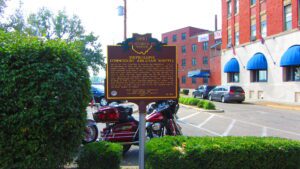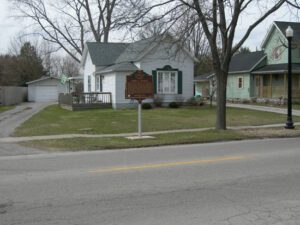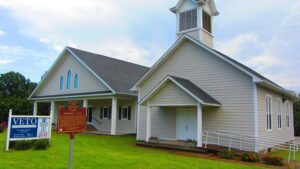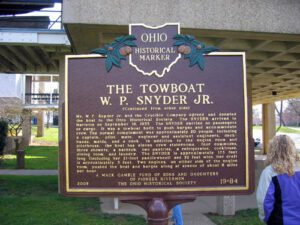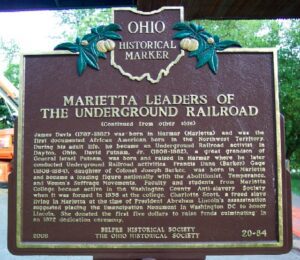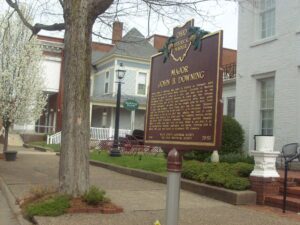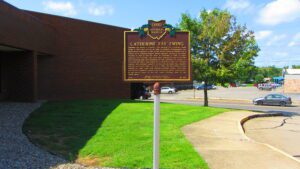, OH
One of the first industries in Marietta was shipbuilding. Due to the abundance of trees and the shipbuilding talent of the New England settlers, twenty-nine ocean going vessels were built in eight shipyards from 1800 to 1812. In 1845 shipbuilding resumed and seven more vessels were constructed. The last ship left dry dock in 1847. The first vessel built was the 110-ton brig St.Clair, captained by Commodore Abraham Whipple. Whipple was a noted Revolutionary War naval officer who escaped the British blockade in 1778 to carry important dispatches to France. He later captured ten vessels worth one million dollars from a British convoy and, in 1784, was the first to fly the American flag on the River Thames in England.
, OH
Born July 25, 1832, near Worthington, Ohio, John Alf Wilson lived at this site. At the age of 29, he enlisted in C. Company, 21st Ohio Volunteer Infantry under General O.M. Mitchell. General Mitchell consented to a dangerous mission led by John Andrews to cripple Confederate supply lines. Alf Wilson was one of 22 men who volunteered to steal a train and destroy track and railroad bridges and cut telegraph wires on the route through Georgia to Chattanooga. The “Andrews Raiders” boarded the train in Marietta, Georgia, and seized the engine, The General, at Big Shanty. Its crew and Confederate soldiers pursued The General until it gave out before reaching Chattanooga. Eventually, all the Raiders were captured. Several, including Wilson, escaped from prison, while Andrews and seven men were tried as spies and hung. Wilson was captured again before returning to Wood County. He was awarded the Medal of Honor in 1863.
, OH
Ephraim Cutler (1767-1853) arrived in Marietta from Connecticut in 1795. Prominent in southeast Ohio, Cutler was appointed judge of the court of common pleas and justice of the peace, surveyed land for the Ohio Company, and was a trustee of Ohio University. In 1802, Cutler was chosen as a Washington County delegate to Ohio’s constitutional convention in Chillicothe. A contested issue at the convention was whether to permit or exclude slavery in the new state of Ohio. As a member of the committee that introduced Article VIII, or the bill of rights, of Ohio’s Constitution, Cutler drafted Section 2, which specifically excluded slavery or involuntary servitude in Ohio on the basis that the Ordinance of 1787 forbade it. The section passed through the convention by one vote. Veto Lake was named for Cutler’s role in having slavery vetoed in Ohio.
, OH
The W.P. SNYDER Jr. is one of the few links between the age of steam-powered, stern-wheeled towboats and the diesel-powered, propeller-driven vessels that push barges on America’s rivers today. The James Rees and Sons Company in Pittsburgh built the boat for the Carnegie Steel Company, and she was launched in 1918 as the W.H. CLINGERMAN. During the boat’s working life, she primarily pushed barges loaded with coal on the Monongahela and Ohio Rivers. After various changes in name, the Crucible Steel Company of America bought the boat in 1945 and named her the W.P. SNYDER Jr. after the company’s president. Crucible retired the SNYDER in 1954 and, as was the fate of her kind, she would have probably been scrapped. In 1955, however, the Sons and Daughters of Pioneer Rivermen and the Ohio Historical Society concluded that one example of a steam towboat should be preserved. (continued on the other side)
, OH
People living in Marietta and along the Muskingum River shared a history of slavery opposition. Manasseh Cutler, from Massachusetts and an Ohio Land Company agent, helped draft the Ordinance of 1787 that prohibited slavery in the Northwest Territory. General Rufus Putnam, Captain Jonathan Stone, and other Ohio Land Company Revolutionary War veterans, founded Marietta at the mouth of the Muskingum River in 1788 bringing with them their anti-slavery sentiments. A proposal to legalize slavery in the proposed state of Ohio was vetoed largely due to the efforts of Marietta’s Ephraim Cutler and General Putnam at the 1802 Ohio Constitutional Convention. These conditions were precursors toward the formation of the Underground Railroad as fugitive slaves crossed the Ohio River seeking freedom. From 1812 through 1861, large numbers of fugitive slaves fleeing toward Canada, were aided by descendants of early settlers who operated Underground Railroad Stations along the Muskingum River. (Continued on other side)
, OH
Major John B. Downing was born in Rutland in February 1834, son of Rodney and Marian Black Downing. Educated at Marietta College, he spent 27 years as a pilot and boat owner on the Mississippi River, operating between St. Louis and New Orleans. Downing became one of the most experienced river boat pilots on the Mississippi. As such, he was sought after by Mark Twain to teach him piloting. Later Twain gave him the name “Alligator Jack” and referenced him in his book Life on the Mississippi. Downing also played a role in the Civil War, piloting the fleet in cooperation with General U.S. Grant past the Vicksburg fortress during the famed 1863 Vicksburg Campaign. Downing married Romaine Miller in 1868, and they had two sons, Miller R. and John B. Jr. An accomplished violinist, marksman, and hunter, Downing died in March 1914 and was buried in Middleport Hill Cemetery.
, OH
Frances Dana (Barker) Gage was born on October 12, 1808, in Marietta. She married James L. Gage in 1829 and they raised eight children, including four sons who served with Union forces during the Civil War. Throughout much of her life, Frances was deeply involved with the Temperance and Anti-Slavery movements and Women’s Rights issues. Presiding over the Women’s Rights Convention in Akron in 1851, she invited Sojourner Truth to give her famous “Ain’t I a Woman” speech. The Gage family moved in 1853 to St. Louis, the western extension of the Mason-Dixon Line, where her life was threatened whenever she spoke out against slavery. During the Civil War, she traveled south to aid Union soldiers and teach freed slaves. Though crippled and permanently disabled by a stroke, she continued to lecture on social issues until 1867. Frances Dana Gage died on November 10, 1884, in Greenwich, Connecticut.
, OH
The Peoples Bank Theatre, built in 1919 and called the Hippodrome, marks an age when movies transitioned from silent films and nickelodeons into a major national industry and pastime. Designed by Columbus architect Fred Elliott for the C&M (Cambridge and Marietta) Amusement Company, the theatre featured a granite archway, 1,200 seats, a 35-by-55-foot stage, an orchestra pit, and the first air conditioning of its kind in Marietta. The Hippodrome opened May 9, 1919 with the silent film Daddy Long Legs, starring Mary Pickford. Shea Theatres of New York bought the Hippodrome and remodeled it in 1949, replacing the Hippodrome’s distinctive stone archway with a two-story southern colonial-style facade. Renamed the “Colony,” it opened June 25, 1949, showing the Esther Williams’ musical Neptune’s Daughter. (Continued on other side)


